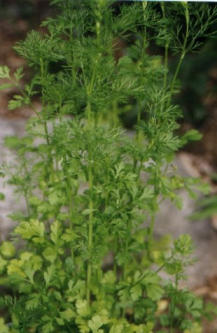» View the recipes involving coriander
 Coriander (Coriandrum sativum) is an annual herb commonly used in Middle Eastern, Mediterranean, Indian, Latin American, Chinese and Southeast Asian cuisine. All parts of the plant are edible, but the fresh leaves and the dried seeds are the most commonly used in cooking. Coriander belongs to the parsley or carrot family, Apiaceae. It is also commonly called cilantro (see below). Coriander (Coriandrum sativum) is an annual herb commonly used in Middle Eastern, Mediterranean, Indian, Latin American, Chinese and Southeast Asian cuisine. All parts of the plant are edible, but the fresh leaves and the dried seeds are the most commonly used in cooking. Coriander belongs to the parsley or carrot family, Apiaceae. It is also commonly called cilantro (see below).
The name coriander derives from Latin coriandrum, which was first noted by Pliny. The Latin word derives in turn from Greek corys, a "bedbug", plus -ander, "resembling", and refers to the supposed similarity of the scent of the crushed leaves to the distinctive odor of bedbugs (which we have largely forgotten in this age of insecticides). The leaves are variously referred to as coriander leaves, cilantro (in the United States, from the Spanish name for the plant), dhania (in the Indian subcontinent, and increasingly, in Britain), Chinese parsley or Mexican parsley. The leaves have a very different taste from the seeds, similar to parsley but "juicier" and with citrus-like notes. Some people instead perceive an unpleasant "soapy" taste and/or a rank smell. This is believed to be a genetic trait, but has yet to be fully researched. The fresh leaves are an essential ingredient in many Asian chutneys and Mexican salsas and guacamole. Chopped coriander leaves are also used as a garnish on cooked dishes such as dal and many curries, but should never themselves be cooked as heat destroys their delicate flavor quickly. Coriander leaves were formerly common in European cuisine but nearly disappeared before the modern period. Today Europeans usually eat coriander leaves only in dishes that originated from foreign cuisines. The fresh coriander herb is best stored in the refrigerator in airtight containers, after chopping off the roots. The leaves do not keep well and should be eaten quickly, as they lose their aroma when dried or frozen. Coriander has been researched for its chelation properties with some success. The dry fruits are known as coriander seeds or simply as coriander. They have have a lemony citrus flavor when crushed. It is also described as warm, nutty, spicy, and orange-flavoured. They are usually dried but can be eaten green. Ground coriander is a major ingredient in curry powder, certain Belgian-style beers and other aromatic dishes. If the spice is bought whole in a non-dried form, it can be dried in the sun. Most commonly, it is bought as whole dried seeds, but can be bought in ground form. Store coriander seed in a tightly sealed container away from sunlight and heat. For maximum flavor use within 6 months and keep for no more than 1 year. It can be roasted or heated on a dry pan briefly to enhance the aroma before grinding it in an electric grinder or with a mortar and pestle; ground coriander seeds lose their flavour quickly in storage and are best only ground as needed. Coriander seed is a key spice in Indian curries and garam masala (Hindi name: dhania), which often employ the ground fruits in generous amounts together with cumin. Outside of Asia, coriander seed is an important spice for sausages in Germany and South Africa (see boerewors). In Russia and Central Europe coriander seed is an occasional ingredient in rye bread as an alternative to caraway. Apart from the uses just noted, coriander seeds are rarely used in European cuisine today, though they were more important in former centuries. Coriander seed is also used in Ethiopian and Arabic cooking.
Season specials: Easter Recipes, Passover Recipes, Christmas Recipes, Season Recipes, Xmas Recipes
|